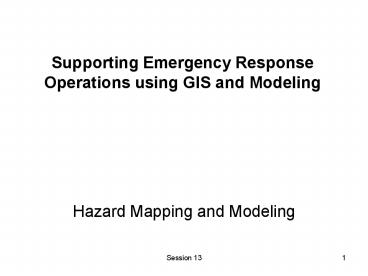Hazard Mapping and Modeling - PowerPoint PPT Presentation
1 / 19
Title:
Hazard Mapping and Modeling
Description:
Identify and explain what spatial information and tools are needed in Emergency Response ... to buildings, critical property, environmental impacts. Session 13 ... – PowerPoint PPT presentation
Number of Views:1717
Avg rating:3.0/5.0
Title: Hazard Mapping and Modeling
1
Supporting Emergency Response Operations using
GIS and Modeling
- Hazard Mapping and Modeling
2
Objectives
- Explain the development and use of GIS and
modeling in supporting emergency response
operations. - Identify and explain what spatial information and
tools are needed in Emergency Response - Explain the organizational requirements for GIS
support in emergency operations
3
Development of GIS in Modeling Emergency Response
Operations
- GIS has been used by state emergency management
agencies in disaster response since Hurricane
Andrew in 1992. - Remote sensing has been used during the last few
years by state and local agencies. - Maps are a key element in communicating complex
data for decision making and for public
information - Data was provided to state and local agencies in
support of emergency response activities
following September 11, 2001. - Examples include Airborne LIDAR and high
resolution images.
4
GIS Applications in Supporting Emergency Response
Operations Include
- Hazard detection
- Identifying vulnerabilities
- Determining critical needs in the aftermath of
disasters - Developing evacuation routes
- Damage assessment mapping
- Risk perception and communication.
5
Ad Hoc Solutions to Collect Remote Sensing Data
- The solution for effective collection, analysis
and use of remotely sensed data for emergency
response, cleanup and recovery from a hazard
event is a loosely structured and ad hoc
approach. - The structure for acquiring and using mapping and
modeling data unfolds as the event develops. - The window of opportunity for emergency response
is very short and roughly 72 hours.
6
Displaying GIS Information for Emergency
Operations
- Disaster forecasting showing the extent and the
areas to be impacted by a disaster - Vulnerability analysis examining information on
critical sites (hospitals, shelters, dams, or
other critical facilities for a potential
disaster). - Damage assessments showing actual impacts
- Personnel resources including the contact
information, location and potential use of
resources. - Resource inventory providing vital information
for supplies, equipment and other items necessary
in an emergency response. - Critical infrastructure (transportation,
utilities, medical and other vital sites for
emergency response and recovery). - Mass care and shelters
7
Geospatial Data is Needed in the Following
Applications
- Event mapping (prediction and warning)
- Response coordination and resource allocation
- Damage assessment
- Environmental monitoring
- Risk assessment
- Risk Communication
- Relief and resource locations
- Identification of vulnerable populations
- Lifeline status
- Evacuation efforts and status of transportation
routes
8
Spatial Information Tools and Technology in
Emergency Response
- Widely available at the state and local levels
9
Question
- What type of geo-spatial data is needed in
emergency response? - Transportation infrastructure (accurate street
and road coverage with street names and address
ranges) - Landcover (land-use classifications)
- Terrain (high resolution USGS DEM using LIDAR)
- Hydrography
- Local parcel data with land-use classifications
and addresses - Demographic information including distribution
10
Question
- How can the data be obtained to support emergency
response activities? - Planning and obtaining data prior to a disaster
is critical. - Other jurisdictions should be contacted for data
layers appropriate for emergency response. - FEMA will provide data to state and local
jurisdictions as part of the overall emergency
response.
11
Emergency Impact Data (collected immediately
following the disaster event)
- Weather conditions
- Flood inundation or nature and extent of the
hazard event - Status of lifelines and other critical
infrastructure (utilities, transportation
networks, levees dams) - Damage to buildings, critical property,
environmental impacts
12
Time Expectancy of Spatial Data
- Much of the data is needed within 24 hours of the
disaster event - In place monitoring is critical to data
collection - Remote sensing imaging is needed immediately
13
Sources of Remote Sensing Data
- Digital Globe (Quickbird)
- Image America
- SPOT
- IKONOS
- Radarsat
- MODIS
- AVHRR
- Landsat
- LIDAR from public and private providers
14
Uses of Remote Sensing Data
- Define the nature and extent of the risk zone
- Weather conditions
- Crop, vegetation, building and other
environmental damage - Status of lifelines
- Debris characteristics
15
Barriers to Using Remote Sensing Data
- Price
- Accuracy of the data
- Spatial resolution
- Time to collect and process the data
- Technical skills of users
16
Barriers to Utilizing Real Time Modeling in
Disaster Response
- Processing time of the program
- Complexity of data input
- Technical skills required of the program
- Spatial resolution of the model outputs
- Accuracy of the model results (limited if any
model verification) - Price of the modeling program
17
Successful Applications of GIS and Modeling
Technologies
- Baseline data must be current and available
- Personnel must be trained
- Software must be integrated
- Up-to-date computers
- Facilitate sharing of digital information
18
Question
- What advantages do outside providers bring to
emergency responses that a designated staff
member might provide over designating an internal
staff member?
19
Question
- What types of organizational structure are needed
for effective use of GIS in emergency response?































